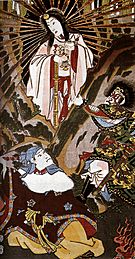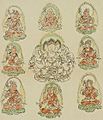Daikokuten facts for kids

In Japan, Daikokuten (大黒天), is one of the Seven Lucky Gods. Daikokuten came from the Indian god, Shiva. Daikoku wears Japanese robes and has a happy and smiling personality.
Contents
Location
Daikoku's pictures are found in the temples of Tibet and China and the god enjoys a high position as a household god in Japan. Daikoku's connection with wealth and success started a strange ritual known as Fuku-nusubi. This ritual started with the belief that the person who stole figures of gods and goddesses was promised good luck, if they were not caught while stealing. Eventually, stealing divine figures became so common that the Toshi-no-ichi or the ‘year-end-market’ held in the Asakusa Kannon temple became the main place where the sale of these images was held.
Purpose
|
Mythic Texts and Folktales: |
Daikoku is considered to be the god of wealth or the household, mostly the kitchen. He is recognised from his wide face, smile, and a flat black hat. He is often shown holding a golden mallet and sitting on bales of rice.
- Japan and Indian Asia by Hajime Nakamura. Publisher: Firma KLM, 1961. Publication Date: 1961
- India and Japan: A Study in interaction during 5th cent - 14th century - By Upendra Thakur.
Iconography

The earliest Japanese representations of Mahākāla-Daikokuten can be classified into two types: one (associated with the Shingon school) shows the deity standing, his left hand holding a sack slung over his shoulder, with his right hand clenched into a fist and resting on the right hip, while the other (associated with the Tendai school) depicts him as sitting. Most of these images show Daikokuten wearing Japanese clothing, though a few has him wearing armor.

Daikokuten's iconography evolved during the 14th century onwards, when he increasingly became portrayed as a smiling man with a rotund belly, holding a mallet and standing or sitting on rice bales.
During the 16th century (late Muromachi period), the three deities Daikokuten, Vaiśravaṇa-Bishamonten and Sarasvatī-Benzaiten were fused together into the three-headed 'Sanmen Daikokuten' (三面大黒天, lit. "Three-Faced Daikokuten").
Worship
The god continues to enjoy an exalted position as a deity of fortune and the household in Japan. Images of Daikokuten can be found in both Buddhist temples and Shinto shrines in the country.
Images for kids
-
11th–12th century stone stele of Mahākāla from Bihar (Metropolitan Museum of Art)
-
Mahākāla (center) flanked by the bodhisattvas Samantabhadra (left) and Mañjuśrī (right). Baocheng Temple, Hangzhou, Zhejiang, China
-
Ming dynasty statue of Dàhēitiān. Sichuan, China. 14th Century (with pedestal from the 16th century)
-
Mahākāla as depicted in the Womb Realm (Garbhadhātu) Maṇḍala, holding an elephant hide, a sword, a human and a goat
-
The iconography of the Buddhist Mahākāla is thought to be based on the mythic episode of Shiva spearing the demon Andhaka with his trident. Note the elephant hide (the skin of Gajāsura, whom Shiva also defeated) in one of his arms.
-
Qing dynasty statuette of Dàhēitiān. China. 17th Century.
-
Statue of Ōkuninushi as Daikokuten in Kanda Shrine (Kanda Myōjin) in Tokyo
-
Daikokuten with rats pulling a radish mikoshi, by Kawanabe Kyōsai
-
Ivory netsuke of Daikokuten with mallet and rat
-
Mandala of Mahākāla and the Aṣṭamātṛkas, from the Kakuzenshō (覚禅鈔), an early Kamakura period iconographic compendium}}
-
Sanmen Daikokuten, a fusion of Daikokuten (center), Bishamonten (left), and Benzaiten (right), by Katsushika Hokusai}}
See also
 In Spanish: Daikokuten para niños
In Spanish: Daikokuten para niños























